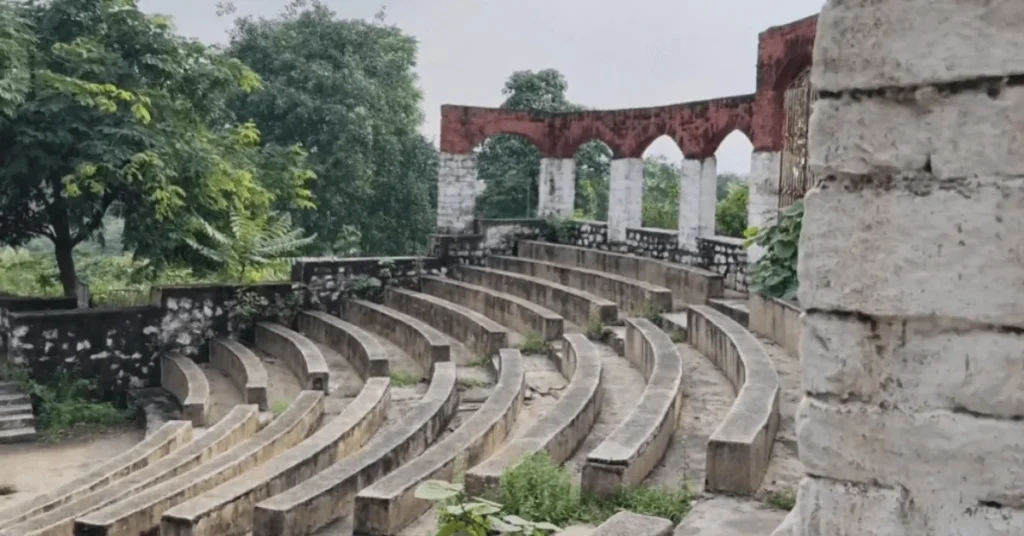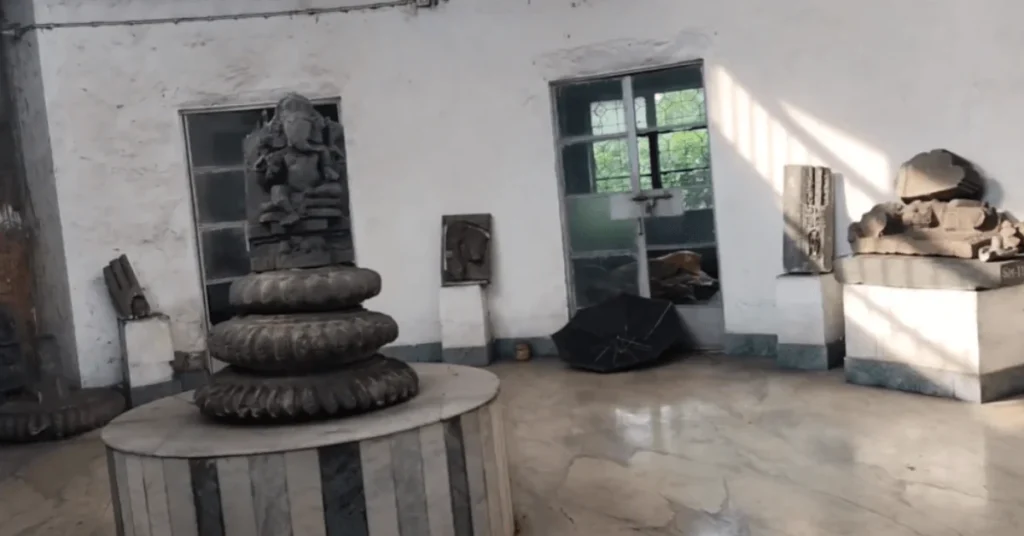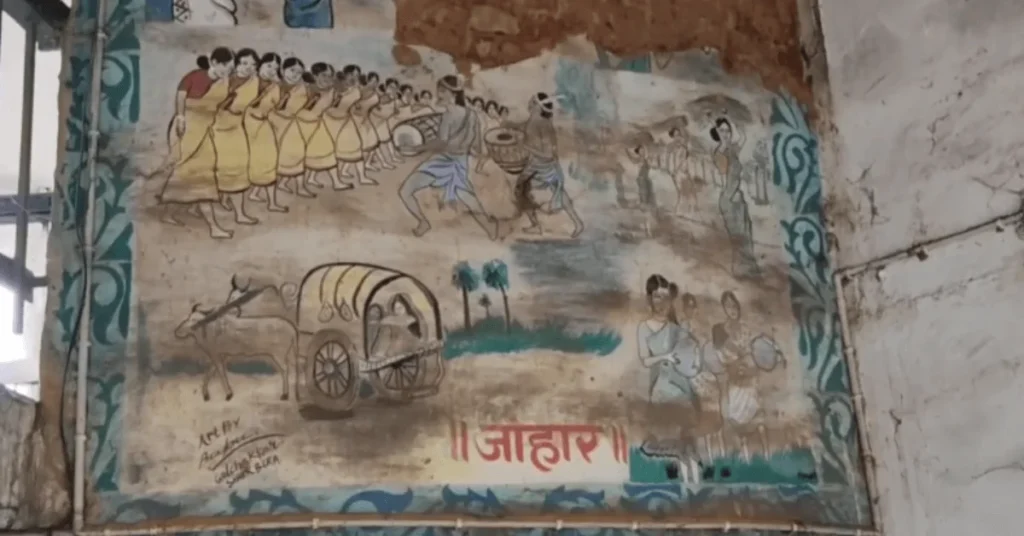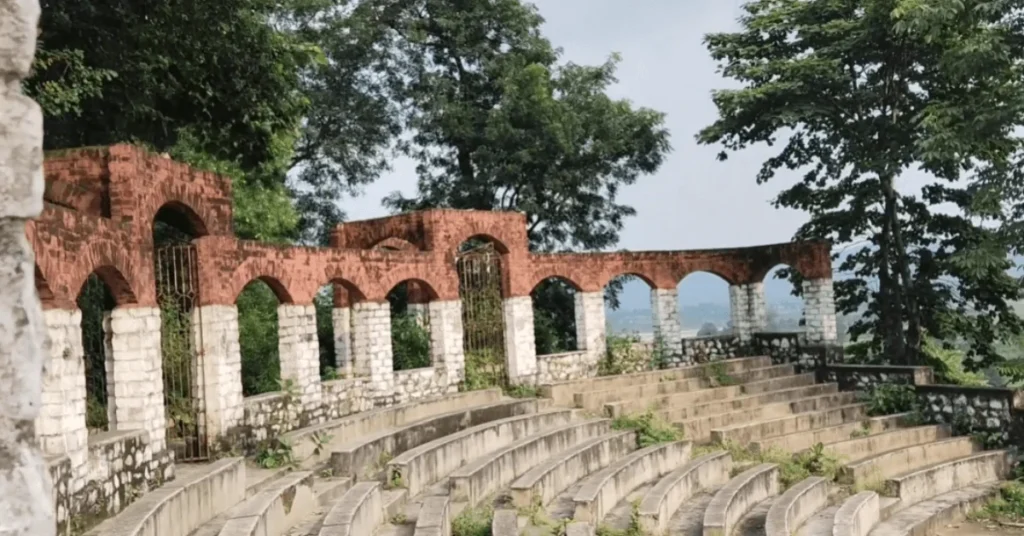Sheesh Mahal near Chandil Dam in Seraikela Kharsawan, Jharkhand. Discover its history, architecture, Patkum Museum, spiritual significance, tourist attractions, best time to visit, local food, and travel tips.
Introduction
The Sheesh Mahal is situated near the Chandil Dam in the Saraikela Kharsawan district of Jharkhand state. Which is very old and dilapidated. This palace is located near Chandil in Ghoraning. This Sheesh Mahal was built at the time of construction of Chandil Dam.
Sheesh Mahal is located at a distance of about 45 kilometers from the district headquarters. One can easily reach here by road. This palace serves as a Patakum Museum. This Sheesh Mahal was built in 1990-92. Many ancient idols are seen in the museum of Sheesh Mahal.
Which is said to have been found while digging during the construction work of the dam. It mainly includes idols of gods like Lord Ganesha, Shiva-Parvati, Nataraja, Parasnath and Vishnu, as well as idols of Lord Mahavir and Chakra inscriptions related to Jainism.
Due to lack of proper facilities here, the idols are getting broken. Many have become useless. Entry is free. The Culture Department decided to set up a Patakum Museum there to preserve the ancient artifacts and stone sculptures found during the excavation of Chandil Dam and named it a bungalow called Sheesh Mahal. A total of 120 statues including Buddhist, Jain and Hindu statues are to be displayed here.
Location and geographical information
The Sheesh Mahal Auditorium is located in the Seraikela-Kharsawan district of Jharkhand state. It is built within the historic Shesh Mahal complex. It is located about 2 km from Seraikela town, about 30 km from Jamshedpur, about 25 km from Chaibasa and about 130 km from Ranchi (capital).
This area falls in the plateau region of Chotanagpur, where a beautiful confluence of greenery and rivers and streams is seen all around. Seraikela-Kharsawan district is world famous for Chhau dance and cultural traditions. The peaceful environment and local life make it an ideal place for cultural events and tourists.
Tourists come here throughout the year, out of which local tourists are more. Every year on January 1, a lot of crowd is seen around this Sheesh Mahal and Chandil Dam. Most of the people come here to enjoy picnics. People come to do boating in the dam and many other entertainment activities.





Construction and Architecture
The Sheesh Mahal was built by the royal family of Seraikela-Kharsawan in 1990-92. The main purpose of its construction was to store the statues found while digging the dam and to make it a centre for royal residence, administrative work and cultural events.
All the statues of this Sheesh Mahal are ancient and made of stone. Talking about architecture, each statue is carved with great precision. This kind of workmanship is not seen anywhere in today’s time. However, some statues are getting damaged due to lack of proper maintenance.
But if the local department here takes care of it and develops it, then this place will attract tourists. Due to which some people here will get a chance to improve their economic condition.
History of Sheesh Mahal
The history of Sheesh Mahal of Seraikela-Kharsawan is associated with the Seraikela princely state and its prosperous dynasty. The royal palace of Seraikela is a symbol of the glorious history of Jharkhand, where the Maharaja Singh Dev family has ruled.
This princely state was established in 1620 by Raja Vikram Singh, a Rajput descendant of Jodhpur. Later, the Kharsawan state was established in 1650 by Kumar Vikram Singh, son of Raja Vikram Singh.
The Durga Temple and the Rashtra Mandir (Radha-Krishna) inside the Sheesh Mahal were also built during this period, where the king used to worship with his family and light the eternal lamp for the well-being of his subjects. The descendants of the king still live in the palace and carry out administrative work.
The Saraikela Palace still reflects the rich art, culture and civilization of our ancestors, and it is a witness to the achievements of the past in the form of the Patakum Museum. It was built by the royal family during the construction of the dam here in 1990-92.
Religious and spiritual significance
Looking at the idols of all the gods and goddesses present in the Sheesh Mahal, it seems that worship must have been done in this palace since ancient times. But this is not seen in today’s time. It seems that all the idols here have been decorated. No one comes here to worship.
This Sheesh Mahal is an auditorium, so it is possible that scientists have done many types of research on these idols according to time. It may also be that it has been decorated like a museum to see all the idols. But from seeing everything, it seems that this place is sacred.
Architectural features
If we talk about the architecture of the Sheesh Mahal, there is nothing special. This auditorium has been built in a normal form. Which has been built to store the idols obtained from Chandil Dam at one place. Talking about the special thing here, the view here is very beautiful.
From here, the view of the surrounding green nature is visible. There is a good view of the dam nearby. The art of the statues inside the palace is amazing. In today’s time, this Sheesh Mahal is slowly getting ruined. If it is not maintained, then it will not be worth seeing in the coming few years.
Shesh Mahal and Chhau Festival
Sheesh Mahal has a variety of artifacts, including statues and inscriptions related to Buddhism, Jainism and Hinduism. These include statues of Lord Ganesha, Shiva-Parvati, Nataraja, Parasnath, and Vishnu.
The Patkum Museum, which is located in the Sheesh Mahal, displays craftsmanship between the fifth and twelfth centuries. Although the description of the Sheesh Mahal’s own distinctive architecture is not clearly given, it is a witness to samples of ancient craftsmanship and thousands of years old historical heritage in the form of a museum.
The museum includes stone statues and inscriptions, which reflect the rich cultural heritage of the region. However, some of the statues are getting damaged due to lack of proper maintenance.
Tourist attractions
Visit to the historic palace
The huge courtyard and majestic Durbar Hall of Shesh Mahal are a special attraction for tourists.
The artworks on the windows, verandahs and walls of the palace show a glimpse of history and architecture.
Chhau Dance Center
Seraikela-Kharsawan is known for the world famous Chhau dance.
The Chhau Dance Center located near the palace trains and performs artists, which is a unique experience for tourists.
Cultural programs and festivals
Cultural festivals and exhibitions are organized from time to time in the Shesh Mahal complex. During the Chhau festival, special dance-drama events are held in the palace, which attract tourists from far and wide.
Local museum and exhibition
The museum located near the palace displays traditional costumes, masks, and items related to the royal family. These museums connect tourists to the folk culture and history of Jharkhand.
Religious and spiritual places
The palace complex and the surrounding temples are the center of local religious faith. Tourists can experience religious rituals and worship here.
Natural Beauty
The Shesh Mahal is surrounded by greenery and serene natural surroundings. This place is an ideal destination for photography and nature lovers.
Picnic and Family Outing
The open grounds and courtyards make it an ideal place for picnics and spending time with family. Local food and small food stalls make the experience more interesting for the tourists.
Nearby Attractions
Tourist places of nearby cities like Jamshedpur and Chaibasa can also be easily visited from here.
- Chandil Dams
- Jayda Temple
- Palna Dam
- Sai mandir
- Akashini Mandir
- Dalma Top
- Hesakocha Waterfall
- King Place
Ways to reach Sheesh Mahal
By Road: Direct road connectivity is available from Jamshedpur and Chaibasa. Chandil Dam is 21 km from Tata Nagar Bus Stand.
By Rail: Nearest Railway Station – Tatanagar (Jamshedpur), approx 30 km. There are regular trains to Chandil from other major cities of the country.
- Raikela Nagar – approx 2 km
- Jamshedpur – approx 30 km
- Chaibasa – approx 25 km
- Ranchi (Capital) – approx 130 km
By Air: Nearest Airport – Birsa Munda Airport, Ranchi (approx 130 km). You can reach Chandil Dam from Kolkata Airport or Ranchi Airport by train.
Best time to visit sheesh mahal
November to February is considered to be the best season to visit Shesh Mahal. The temperature remains between 10°C to 22°C. Chhau Festival is celebrated during this period from March to April, which is the biggest cultural attraction of Shesh Mahal and the whole of Seraikela-Kharsawan. Greenery and natural beauty is at its peak in July to September. Travel and transportation may be difficult due to rain.
Local Food of Seraikela-Kharsawan
The cuisine of Seraikela-Kharsawan is deeply connected to the folk culture and tradition of Jharkhand. The cuisine here includes local grains, pulses, leafy vegetables, tubers and traditional dishes. Dhuska, Pitha, Chiura and Curd, Handi Meat, Sattu, Arsa and Thekua, Saag and tubers, dishes made from Mahua, dishes made from gram and rice, local drinks and sweets including Handia, Rasgulla and Chhena sweets etc.
Accommodation facilities
There is no overnight accommodation facility near Sheesh Mahal. There are many hotels, lodges, guest houses, resorts and hotels in the local town for tourists, homestays and rural tourism, government rest houses, budget travel options, importance of advance booking etc. It is about 20 minutes away from Sheesh Mahal. Where you can spend the night with food and drinks.
FAQ’s
Sheesh Mahal is located near Chandil Dam in Seraikela-Kharsawan district of Jharkhand, around 45 km from the district headquarters and 30 km from Jamshedpur.
Sheesh Mahal was constructed between 1990–92 by the Seraikela royal family to preserve ancient stone idols discovered during the construction of Chandil Dam. It also reflects the cultural legacy of the Seraikela royal dynasty.
The Patkum Museum inside Sheesh Mahal houses around 120 stone idols and artifacts, including deities like Lord Shiva, Vishnu, Parshvanath, Mahavira, Ganesh, and Nataraja, along with Jain and Buddhist relics.
No, entry to Sheesh Mahal is free for all visitors.
The best time to visit is from November to February for pleasant weather, and in March–April during the famous Chhau Mahotsav, which showcases the region’s cultural heritage.
